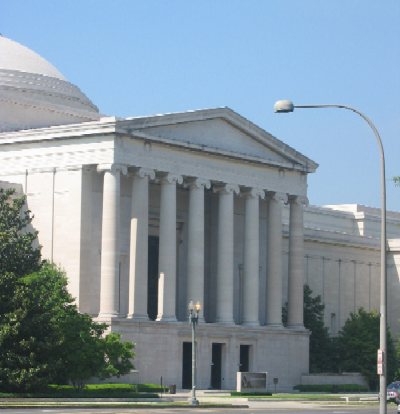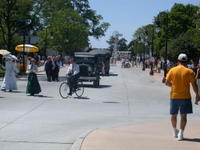Washington, DC: National Portrait Gallery and Smithsonian American Art Museum
 The building is breath-taking, the art is better than I remembered it, and the organization works, mostly. The Smithsonian spent a few hundred million dollars and six years on the project, and it shows. The architecture is crisp, the workmanship first-rate, the design quiet but solid.
The building is breath-taking, the art is better than I remembered it, and the organization works, mostly. The Smithsonian spent a few hundred million dollars and six years on the project, and it shows. The architecture is crisp, the workmanship first-rate, the design quiet but solid.I must admit I was dubious about the project from the start. The SAAM is not a strong collection, as art museums are usually judged. Within a mile or so, the National Gallery, the Phillips, and the Hirschorn have better art works in almost any given category. The NPG has a great collection of portraits, but few that would be considered masterpieces of art; it's a cross between a history museum and an art museum that more often than not partakes of the worst of each category. So both museums start with some real disadvantages.
But sometimes disadvantages can be turned to advantages. The staff of the museums put all those years the museum was shut to good purpose, arraying their collections in ways that show them well, the juxtapositions both within and between the museums producing some fine aesthetic and educational surprises.
 The SAAM has played to its strength: it's a comprehensive collection. That might be another way of saying that it has good and bad, mostly bad. But it also means that a visitor can get an overview of American art--not just what happens to be in fashion at the moment, but much that in other museums would be relegated to storage. And the museum plays to this strength, defining art broadly. It includes decorative arts--the fashion, lately (see the Boston MFA) but done very well here. (I would like to see more.) It includes folk art--some spectacular pieces. It includes popular sculpture pieces like the Roger's groups. It's an expansive collection. One strolls through decades, through schools of art, through regions. There are a variety of interpretive schemes, some more successful than others--I was much taken with "The American Experience" exhibit, art and words together--but less so with some of the interminable modern displays.
The SAAM has played to its strength: it's a comprehensive collection. That might be another way of saying that it has good and bad, mostly bad. But it also means that a visitor can get an overview of American art--not just what happens to be in fashion at the moment, but much that in other museums would be relegated to storage. And the museum plays to this strength, defining art broadly. It includes decorative arts--the fashion, lately (see the Boston MFA) but done very well here. (I would like to see more.) It includes folk art--some spectacular pieces. It includes popular sculpture pieces like the Roger's groups. It's an expansive collection. One strolls through decades, through schools of art, through regions. There are a variety of interpretive schemes, some more successful than others--I was much taken with "The American Experience" exhibit, art and words together--but less so with some of the interminable modern displays.  A conservation lab and an open storage area are exceptionally well done; the money that was spent on them shows. I'm usually dubious about open storage, for it is too often a chance for museums to avoid doing the work of explanation. But here, with a well-designed computer access system and a helpful person at the desk, it works. The SAAM, with its comprehensive collections, is in some ways open storage by nature; the Luce Center extends it nicely.
A conservation lab and an open storage area are exceptionally well done; the money that was spent on them shows. I'm usually dubious about open storage, for it is too often a chance for museums to avoid doing the work of explanation. But here, with a well-designed computer access system and a helpful person at the desk, it works. The SAAM, with its comprehensive collections, is in some ways open storage by nature; the Luce Center extends it nicely.The NPG is working under more difficult constrains. It's a history museum that uses portraits to tell its stories, a rather limiting medium. The staff has done an admirable job of finding portraits to tell a diverse range of stories, and telling them in a range of ways--but it's still one damn person after another, with not much connecting tissue. The museum has borrowed a few objects to round out the story, which is nice; more would be better. Portraits are a limiting medium; the museum should take advantage of other artifacts to help tell the story. But given its constraints, it's done a good job, especially for those individuals where it goes beyond portraiture to biography. Walt Whitman is the best example: a pleasing variety of interpretative techniques, some well written labels, even a curator's personal statement. It's weak when it tries to go from portraiture to history, as in the Cold War exhibit. And it's weakest, of course, where portraits fail: Native Americans are shown from a white perspective, and the African American experience before 1840 or so is reduced to a few leaders.
 But still, both museums are worth a visit, and the sum is greater than the parts. The NPG and the SAAM share the building in interesting ways; the visitor walks from one to another, at times not sure whether what you see is art, or portraiture, or both. (My favorite piece, a Nina Levy sculpture, left, shows the possibilities.)
But still, both museums are worth a visit, and the sum is greater than the parts. The NPG and the SAAM share the building in interesting ways; the visitor walks from one to another, at times not sure whether what you see is art, or portraiture, or both. (My favorite piece, a Nina Levy sculpture, left, shows the possibilities.)But overall, the two museums work, at least for those who care about the subject. I doubt that either museum will attract much of a crowd--neither play to the masses, those with a general interest in art will stay on the mall, at the National Gallery or the other Smithsonian museums, and there's not much here to attract families. And indeed, after the first weekend, turnout has been disappointing.









